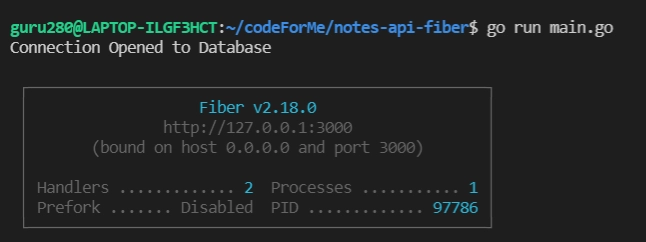Go Fiber:开始在 Golang 上构建 RESTful API(Feat. GORM)
📚 内容
让我们用简单的英语学习科技
如果您更擅长编写代码而不是文本,请直接跳转到已完成的项目,对其进行分叉并开始添加您的代码 -
 percoguru /教程笔记-api-go-fiber
percoguru /教程笔记-api-go-fiber
使用 Go 构建 RESTful API:功能包括 Fiber、Postgres、GORM
👷 我们正在构建什么 ↑
我们将用 Go 语言构建一个简单的笔记 API,以建立一个基础代码库,用于扩展和创建完整的后端服务。我们创建的框架将帮助您理解并开始使用 Go 语言的 API。
如果您想知道如何开始用 Go 语言开发 API,或者您刚刚掌握 Go 语言的基础知识并希望开始实际开发,那么这将是一个绝佳的起点。
🚅 前往 ↑
Go 语言已经存在十多年了。它深受人们喜爱,学习和使用起来也非常有趣。
虽然可以使用 Go 构建功能齐全的全栈 Web 应用程序,但本文旨在学习如何用 Go 语言构建基本的 Web API,因此我们将只讨论 API。
⏩ Express 和 Fiber ↑
过去十年来,Node.js 一直深受后端服务开发者的喜爱。
使用 Express 方式开发 API,无论对经验丰富的 Node.js 开发者还是 Go 语言新手来说都非常友好。因此,Fiber 的构建也充分考虑了 Express 的理念。Fiber
是一个 Go 语言的 Web 框架,它从零开始就为 API 做好了准备,支持中间件,并且性能超快。我们将使用 Fiber 来创建我们的 Web API。
📁 最终项目结构
让我们首先看看我们的最终结构是什么样的 -
notes-api-fiber
|
- config
| - config.go
|
- database
| - connect.go
| - database.go
|
- internal
| |
| - handler
| | - note
| | - noteHandler.go
| |
| - model
| | - model.go
| |
| - routes
| - note
| - noteRoutes.go
|
- router
| - router.go
|
- main.go
- go.mod
- go.sum
不用担心,我们将从一个文件开始构建,并在构建过程中通过足够的逻辑和解释达到这一状态。
🎒 软件包基础知识 -
Go 代码以包的形式分发,我们将会创建很多这样的包。Go 包用于根据用途分发代码和逻辑。这在我们上面绘制的目录结构中也可以看到。
package <package_name>我们通过在顶部写入来声明文件的包名称。- 简单来说,包是 go 项目中共享变量和函数的一组代码。
- 同一包中的任意数量的文件共享变量、函数、类型、接口,基本上任何定义。
- 为了正确访问包的任何代码,包的所有文件都应位于单个目录中。
💡 让我们开始使用 API ↑
我们将从一个文件开始,这是我们代码的起点 - main.go。在我们项目的根目录中创建此文件。
主程序 ↑
我们先从编写根文件开始main.go。这将是应用程序的起点。现在,我们只在这里初始化一个 Fiber 应用。稍后我们会添加更多内容,这里将成为设置发生的地方。
主程序
package main
import (
"github.com/gofiber/fiber/v2"
)
func main() {
// Start a new fiber app
app := fiber.New()
// Listen on PORT 300
app.Listen(":3000")
}
让我们创建一个端点 ↑
为了对如何创建 API 端点有一个基本的了解,我们首先创建一个虚拟端点来开始。
如果你曾经使用过 Express,你可能会注意到它们之间的相似之处;如果你没有使用过 Express,你就会发现它们之间的相似之处恰恰相反。
主程序
package main
import (
"github.com/gofiber/fiber/v2"
)
func main() {
// Start a new fiber app
app := fiber.New()
// Send a string back for GET calls to the endpoint "/"
app.Get("/", func(c *fiber.Ctx) error {
err := c.SendString("And the API is UP!")
return err
})
// Listen on PORT 3000
app.Listen(":3000")
}
通过运行运行服务器
go run main.go
在根目录中。然后转到localhost:3000。您将看到如下页面:
现在,我们已经了解了如何从包含几行代码的单个文件启动 API。
请注意,您可以继续在此处添加更多端点并进行扩展。这种情况在本文中会多次出现,但我们不会垂直扩展,而是尽可能水平分布代码。
现在我们的项目目录看起来像 -
notes-api-fiber
|
- main.go
💼 Go 模块 ↑
我们的项目将成为一个 Go 模块。要了解更多关于 Go 模块的信息,请访问https://golang.org/ref/mod。要在项目目录中启动 Go 模块,请运行以下命令:
go mod init <your_module_url>
通常<your_module_url>表示您的模块将发布到哪里。目前,您可以使用您的 Github 个人资料。例如 - 如果您的 Github 用户名是percoguru,您将运行
go mod init github.com/percoguru/notes-api-fiber
路径的最后一部分是项目名称。
现在,您创建的任何包都将成为此模块内的子目录。例如,一个包foo将被模块中的另一个包以 的形式导入github.com/percoguru/notes-api-fiber/foo。
运行该命令后,go.mod将创建一个文件,其中包含有关我们模块的基本信息以及我们将要添加的依赖项。这可以被视为package.jsonGo 的等效文件。
你的go.mod遗嘱如下:
go.mod
module github.com/percoguru/notes-api-fiber
go 1.17
📐 设置要点 ↑
现在我们将设置一些基本的东西来支持我们的 API -
- Makefile
- 数据库(PostgreSQL)
- 模型
- 环境变量
Makefile ↑
随着我们引入越来越多的更改,go run main.go每次我们希望更改反映在正在运行的服务器上时,都需要运行。要启用服务器的热重载,请Makefile在目录的根目录中创建一个。
- 安装反射
go install github.com/cespare/reflex@latest
- 将命令添加到您的
Makefile
build:
go build -o server main.go
run: build
./server
watch:
reflex -s -r '\.go$$' make run
- 跑步
make watch
- 对您的代码进行任何更改并在终端中查看服务器重新加载。
💾 数据库 ↑
在本文中,我们将使用 Postgres 作为数据库实现。
虽然我们这里只是开发一个笔记应用,但本文的目的是帮助你在此基础上进行扩展。我甚至鼓励你现在就尝试一下数据库模式,添加新的实体或使用除笔记之外的其他东西。SQL 非常适合这种扩展,如果你决定在此基础上进一步扩展,就无需再探索其他选项了。
在您的机器上运行 Postgres,并为我们的实现创建一个数据库 fiber-app - 按照https://www.postgresql.org/download/上的说明进行操作
⚙️ 添加配置 ↑
我们将.env在项目目录的根目录中添加一个环境变量文件。当我们连接到数据库时,我们需要一些变量,我们将这些变量存储在这个文件中。
.env
DB_HOST= localhost
DB_NAME= fiber-app
DB_USER= postgres
DB_PASSWORD= postgres
DB_PORT= 5432
除了密码之外,上述值很可能也保持不变,密码将由您为 postgres 用户选择。请记住在继续操作之前创建一个数据库 fiber-app。
现在我们需要从文件中获取这些变量.env。为此,我们将创建一个文件,package config用于提供项目的配置。在目录的根目录下
创建一个文件夹,并在其中创建一个文件。 首次运行 -configconfig.go
go get github.com/joho/godotenv
config.go
package config
import (
"fmt"
"os"
"github.com/joho/godotenv"
)
// Config func to get env value
func Config(key string) string {
// load .env file
err := godotenv.Load(".env")
if err != nil {
fmt.Print("Error loading .env file")
}
// Return the value of the variable
return os.Getenv(key)
}
🔄 连接数据库 ↑
在项目的根文件夹中,创建一个名为 的目录database。所有与数据库连接和迁移相关的代码都将驻留在此目录下。这将成为与数据库连接操作相关的包,我们将其命名为database。
我们将使用 ORM(对象关系映射)作为 Go 代码和 SQL 数据库之间的中间件。本文将选择 GORM 作为 ORM 的首选。它支持 Postgres、关联、钩子以及一项对我们初期帮助很大的功能——自动迁移。
运行以下命令添加 gorm 及其 postgres 驱动程序:
go get gorm.io/gorm
go get gorm.io/driver/postgres
连接.go
package database
import (
"fmt"
"log"
"strconv"
"github.com/percoguru/notes-api-fiber/config"
"gorm.io/driver/postgres"
"gorm.io/gorm"
)
// Declare the variable for the database
var DB *gorm.DB
// ConnectDB connect to db
func ConnectDB() {
var err error
p := config.Config("DB_PORT")
port, err := strconv.ParseUint(p, 10, 32)
if err != nil {
log.Println("Idiot")
}
// Connection URL to connect to Postgres Database
dsn := fmt.Sprintf("host=%s port=%d user=%s password=%s dbname=%s sslmode=disable", config.Config("DB_HOST"), port, config.Config("DB_USER"), config.Config("DB_PASSWORD"), config.Config("DB_NAME"))
// Connect to the DB and initialize the DB variable
DB, err = gorm.Open(postgres.Open(dsn))
if err != nil {
panic("failed to connect database")
}
fmt.Println("Connection Opened to Database")
}
注意如何connect.go导入包config。它在文件夹内查找包./config。
我们已经创建了数据库连接器,但运行应用程序时会运行go run main.go。目前我们还没有调用函数connectDB()。我们需要调用它才能连接到数据库。
让我们转到main.go文件并连接到数据库。我们希望在服务器运行时连接到数据库。因此,我们可以从包 main 的connectDB()函数中调用该函数。main
主程序
package main
import (
"github.com/gofiber/fiber/v2"
"github.com/percoguru/notes-api-fiber/database"
)
func main() {
// Start a new fiber app
app := fiber.New()
// Connect to the Database
database.ConnectDB()
// Send a string back for GET calls to the endpoint "/"
app.Get("/", func(c *fiber.Ctx) error {
err := c.SendString("And the API is UP!")
return err
})
// Listen on PORT 3000
app.Listen(":3000")
}
现在运行
go run main.go
我们尚未对数据库进行任何操作。我们将创建模型来表示我们想要存储在数据库中的表。
🔖 添加模型
internal在目录根目录下创建一个文件夹。我们所有的内部逻辑(模型、类型、处理程序、路由、常量等)都将存储在此文件夹中。
在此文件夹中创建一个文件夹model,然后创建一个文件model.go。这样就创建了internal/model/model.go。文件夹 model 将包含我们的package model。
我们目前只创建一个模型 - note,您可以在此处添加更多模型,或者使用 note 以外的其他模型,例如product、page等。一定要发挥创造力。即使您选择使用其他模型(顺便说一句,我鼓励您这样做😉),代码的其他部分也基本保持不变,所以,请大胆尝试。
我们的 Notes 表如下所示 -
- ID uuid
- 标题文本
- 副标题文本
- 文本文本
要在 Go 中使用 uuid 类型,请运行 -
go get github.com/google/uuid
要创建此模型,请将其添加到model.go文件中 -
package model
import (
"github.com/google/uuid"
"gorm.io/gorm"
)
type Note struct {
gorm.Model // Adds some metadata fields to the table
ID uuid.UUID `gorm:"type:uuid"` // Explicitly specify the type to be uuid
Title string
SubTitle string
Text string
}
请注意
ID uuid.UUID `gorm:"type:uuid"`
我们首先告诉 Go 这个结构字段的类型,uuid.UUID然后通过指定标签告诉 GORM 创建具有 uuid 类型的列gorm:"type:uuid"
🔁 自动迁移
GORM 支持自动迁移,因此无论何时您对模型结构进行更改(例如添加列、更改类型、添加索引)并重新启动服务器,更改都会自动反映在数据库中。
请注意,为了避免意外丢失数据,如果您在结构体中执行了迁移操作,GORM 不会自动删除列。不过,您可以配置 GORM 来执行此操作。
进入你的database/connect.go文件并添加一行以在连接到数据库后自动迁移
...
// Connect to the DB and initialize the DB variable
DB, err = gorm.Open(postgres.Open(dsn))
if err != nil {
panic("failed to connect database")
}
fmt.Println("Connection Opened to Database")
// Migrate the database
DB.AutoMigrate(&model.Note{})
fmt.Println("Database Migrated")
}
现在,重启服务器。您的数据库已迁移。您可以登录 Postgres 来验证迁移是否成功;在 Linux 上,您可以使用 psql;在 Windows 上,您可以使用 pgAdmin 或 DBeaver。
在 Ubuntu 上,使用 psql时:
- 连接到数据库 notes-api
\c notes-api
- 获取有关注释表的详细信息请注意,GORM 将结构名称复数化为表名称,另请注意下图中如何根据结构中的相应字段名称处理字段名称
\d+ notes
输出:当我们在结构体顶部 添加时,GORM 已添加额外的字段。 现在,我们已经验证了迁移,并且模型已保存在数据库中。😎
gorm.Model
现在让我们重新审视一下我们的项目结构 -
notes-api-fiber
|
- config
| - config.go
|
- database
| - connect.go
|
- internal
| |
| |- model
| | - model.go
|
- main.go
- go.mod
- go.sum
- .env
🚡 添加路线 ↑
我们的 API 将包含路由,这些路由是浏览器、Web 或移动应用程序用来对数据执行 CRUD 操作的端点。
首先,我们设置一个基本的路由器来启动 Fiber 应用的路由。在项目的根目录中
创建一个文件夹router,并在其中创建一个文件router.go。
在文件中添加以下代码:
package router
import "github.com/gofiber/fiber/v2"
func SetupRoutes(app *fiber.App) {
}
我们刚刚在 router 包中声明了一个函数 SetupRoutes,它接受一个 Fiber 应用作为参数。该函数将接收一个 Fiber 应用,并将对该应用的调用路由到特定的路由或路由处理程序。API
根据参数分组,Fiber 允许我们这样做。例如,如果有三个 API 端点:
- GET
api/user/:userId-通过 userId 获取用户 - GET——
api/user获取所有用户 - PUT
api/user/:userId-使用 userId 更新用户
我们不必写出所有重复的参数。我们可以这样做:
...
app := fiber.App()
api := app.Group("api")
user := api.Group("user")
user.GET("/", func(c *fiber.Ctx) {} )
user.GET("/:userId", func(c *fiber.Ctx) {} )
user.PUT("/:userId" ,func(c *fiber.Ctx) {} )
当我们扩展并添加大量 API 和复杂路由时,这非常有用。
请注意,“api”的类型为 fiber.Router,“app”的类型为 fiber.App,并且它们都具有 Group 函数。
🔨路线 ↑
我们希望保留像这样的路线SERVER_HOST/api/param1/param2。因此,我们将这行添加到我们的函数中SetupRoutes-
api := app.Group("/api", logger.New()) // Group endpoints with param 'api' and log whenever this endpoint is hit.
处理程序logger.New()还将记录所有 API 调用及其状态。
现在,正如我之前所说,我们将水平扩展,我们可以在main.go文件本身中添加与注释相关的路由,但我们创建了一个路由器包来处理 API 路由。现在,当 API 扩展时,您将添加很多模型,因此我们无法在路由器包中添加添加注释 API。
我们将为每个模型添加特定的路由器,现在为 Notes
在文件夹 内internal创建一个文件夹,routes我们将在其中为与模型相关的所有路由创建子目录。在 routes 文件夹中添加一个文件夹,note并在文件夹内添加一个文件note.go。
您已创建 -
internal/routes/note/note.go
在文件中note.go添加以下代码 -
package noteRoutes
import "github.com/gofiber/fiber/v2"
func SetupNoteRoutes(router fiber.Router) {
}
函数 SetupNoteRoutes 接受一个 fiber.Router 参数,并处理笔记模型的端点。因此添加以下代码:
note := router.Group("/note")
我们将在笔记路由中添加 CRUD(创建、读取、更新、删除)操作。因此 -
package noteRoutes
import "github.com/gofiber/fiber/v2"
func SetupNoteRoutes(router fiber.Router) {
note := router.Group("/note")
// Create a Note
note.Post("/", func(c *fiber.Ctx) error {})
// Read all Notes
note.Get("/", func(c *fiber.Ctx) error {})
// Read one Note
note.Get("/:noteId", func(c *fiber.Ctx) error {})
// Update one Note
note.Put("/:noteId", func(c *fiber.Ctx) error {})
// Delete one Note
note.Delete("/:noteId", func(c *fiber.Ctx) error {})
}
请注意,我们必须编写处理程序函数来执行我们为所有 API 端点注释的任务,
我们将在单独的包中编写这些处理程序
🔧 处理程序 ↑
处理程序是接收 Fiber 上下文 (fiber.Ctx) 并处理请求、发送响应或仅充当中间件并将权限传递给下一个处理程序的函数。
要了解有关处理程序和中间件的更多信息,请访问Fiber 文档
。在文件夹 中internal添加一个文件夹,handlers该文件夹将包含所有 API 处理程序,每个模型都有一个特定的子目录。因此,请note在其中创建一个文件夹,并在其中handlers添加一个文件。 您刚刚创建了 -note.gonote
internal/handlers/note/note.go
现在我们将在routes/note/note.go文件中添加我们需要的处理程序handlers/note/note.go。
处理程序/note/note.go
package noteHandler
- 添加阅读笔记处理程序 -
func GetNotes(c *fiber.Ctx) error {
db := database.DB
var notes []model.Note
// find all notes in the database
db.Find(¬es)
// If no note is present return an error
if len(notes) == 0 {
return c.Status(404).JSON(fiber.Map{"status": "error", "message": "No notes present", "data": nil})
}
// Else return notes
return c.JSON(fiber.Map{"status": "success", "message": "Notes Found", "data": notes})
}
- 添加创建注释处理程序 -
func CreateNotes(c *fiber.Ctx) error {
db := database.DB
note := new(model.Note)
// Store the body in the note and return error if encountered
err := c.BodyParser(note)
if err != nil {
return c.Status(500).JSON(fiber.Map{"status": "error", "message": "Review your input", "data": err})
}
// Add a uuid to the note
note.ID = uuid.New()
// Create the Note and return error if encountered
err = db.Create(¬e).Error
if err != nil {
return c.Status(500).JSON(fiber.Map{"status": "error", "message": "Could not create note", "data": err})
}
// Return the created note
return c.JSON(fiber.Map{"status": "success", "message": "Created Note", "data": note})
}
- 添加获取注释处理程序
func GetNote(c *fiber.Ctx) error {
db := database.DB
var note model.Note
// Read the param noteId
id := c.Params("noteId")
// Find the note with the given Id
db.Find(¬e, "id = ?", id)
// If no such note present return an error
if note.ID == uuid.Nil {
return c.Status(404).JSON(fiber.Map{"status": "error", "message": "No note present", "data": nil})
}
// Return the note with the Id
return c.JSON(fiber.Map{"status": "success", "message": "Notes Found", "data": note})
}
- 添加更新注释处理程序
func UpdateNote(c *fiber.Ctx) error {
type updateNote struct {
Title string `json:"title"`
SubTitle string `json:"sub_title"`
Text string `json:"Text"`
}
db := database.DB
var note model.Note
// Read the param noteId
id := c.Params("noteId")
// Find the note with the given Id
db.Find(¬e, "id = ?", id)
// If no such note present return an error
if note.ID == uuid.Nil {
return c.Status(404).JSON(fiber.Map{"status": "error", "message": "No note present", "data": nil})
}
// Store the body containing the updated data and return error if encountered
var updateNoteData updateNote
err := c.BodyParser(&updateNoteData)
if err != nil {
return c.Status(500).JSON(fiber.Map{"status": "error", "message": "Review your input", "data": err})
}
// Edit the note
note.Title = updateNoteData.Title
note.SubTitle = updateNoteData.SubTitle
note.Text = updateNoteData.Text
// Save the Changes
db.Save(¬e)
// Return the updated note
return c.JSON(fiber.Map{"status": "success", "message": "Notes Found", "data": note})
}
- 添加删除注释处理程序
func DeleteNote(c *fiber.Ctx) error {
db := database.DB
var note model.Note
// Read the param noteId
id := c.Params("noteId")
// Find the note with the given Id
db.Find(¬e, "id = ?", id)
// If no such note present return an error
if note.ID == uuid.Nil {
return c.Status(404).JSON(fiber.Map{"status": "error", "message": "No note present", "data": nil})
}
// Delete the note and return error if encountered
err := db.Delete(¬e, "id = ?", id).Error
if err != nil {
return c.Status(404).JSON(fiber.Map{"status": "error", "message": "Failed to delete note", "data": nil})
}
// Return success message
return c.JSON(fiber.Map{"status": "success", "message": "Deleted Note"})
}
📨 将处理程序连接到路由 ↑
在注释路由中添加处理程序,将文件更改routes/note/note.go为 -
路线/注释/note.go
package noteRoutes
import (
"github.com/gofiber/fiber/v2"
noteHandler "github.com/percoguru/notes-api-fiber/internals/handlers/note"
)
func SetupNoteRoutes(router fiber.Router) {
note := router.Group("/note")
// Create a Note
note.Post("/", noteHandler.CreateNotes)
// Read all Notes
note.Get("/", noteHandler.GetNotes)
// // Read one Note
note.Get("/:noteId", noteHandler.GetNote)
// // Update one Note
note.Put("/:noteId", noteHandler.UpdateNote)
// // Delete one Note
note.Delete("/:noteId", noteHandler.DeleteNote)
}
注意,由于文件夹名称和包名称不匹配,noteHandler 是如何导入的,如果要避免这种情况,请将文件夹也命名为 noteHandler
📨 设置笔记路线 ↑
在文件中设置注释路线router/router.go,将其编辑为 -
路由器/router.go
package router
import (
"github.com/gofiber/fiber/v2"
"github.com/gofiber/fiber/v2/middleware/logger"
noteRoutes "github.com/percoguru/notes-api-fiber/internals/routes/note"
)
func SetupRoutes(app *fiber.App) {
api := app.Group("/api", logger.New())
// Setup the Node Routes
noteRoutes.SetupNoteRoutes(api)
}
📨设置路由器 ↑
到目前为止,我们已经创建了路由器并用它来设置笔记路由,现在我们需要在主函数中设置这个路由器。在主
函数中,main.go删除我们之前创建的虚拟端点,并添加以下代码:
router.setupRoutes(app)
将您的转化main.go为 -
主程序
package main
import (
"github.com/gofiber/fiber/v2"
"github.com/percoguru/notes-api-fiber/database"
"github.com/percoguru/notes-api-fiber/router"
)
func main() {
// Start a new fiber app
app := fiber.New()
// Connect to the Database
database.ConnectDB()
// Setup the router
router.SetupRoutes(app)
// Listen on PORT 3000
app.Listen(":3000")
}
瞧!💥💰
我们做到了!
跑步
make watch
在 Postman 上尝试一下这些端点。一切运行良好。
接下来是什么?
现在,您已经用 Go 从零开始构建了一个 Web API。您了解了 Go、Fiber、GORM 和 Postgres 之间的细微差别。这是一个基本的设置,您可以将您的 API 扩展为一个全栈 Web 应用程序 -
 后端开发教程 - Java、Spring Boot 实战 - msg200.com
后端开发教程 - Java、Spring Boot 实战 - msg200.com
